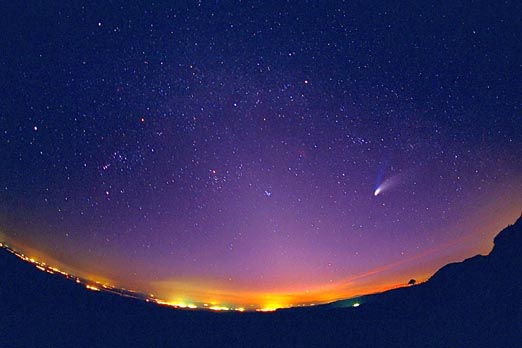Credit & Copyright: J. C. Casado
Explanation:
Thousands of stars, several constellations, a planet and a comet
all graced the western horizon over Ujue,
Spain
just after sunset on April 4th, 1997.
Because the picture was taken with a fisheye lens,
much of the
whole night sky is visible.
Comet Hale-Bopp,
with both tails blazing, appears right of center. The brightest star is
Sirius near the edge, well to the left of the
constellation Orion.
The red star above the
belt
of Orion is
Betelgeuse,
while the red star near the center is
Aldebaran, just to the left of the bright
Pleaides star cluster.
Many other interesting astronomical objects are visible, including
zodiacal light,
which is the diffuse triangular glow in the center.
Even the planet Mercury appears just over the horizon.
1999 2000 2001 2002 2003 2004 2005 2006 2007 2008 2009 2010 2011 2012 2013 2014 2015 2016 2017 2018 2019 2020 2021 2022 2023 2024 2025 |
Yanvar' Fevral' Mart Aprel' Mai Iyun' Iyul' Avgust Sentyabr' Oktyabr' Noyabr' Dekabr' |
NASA Web Site Statements, Warnings, and Disclaimers
NASA Official: Jay Norris. Specific rights apply.
A service of: LHEA at NASA / GSFC
& Michigan Tech. U.
|
Publikacii s klyuchevymi slovami:
Comet Hale-Bopp - kometa Heila-Boppa - zodiakal'nyi svet - Pleyady - rybii glaz
Publikacii so slovami: Comet Hale-Bopp - kometa Heila-Boppa - zodiakal'nyi svet - Pleyady - rybii glaz | |
Sm. takzhe:
Vse publikacii na tu zhe temu >> | |
